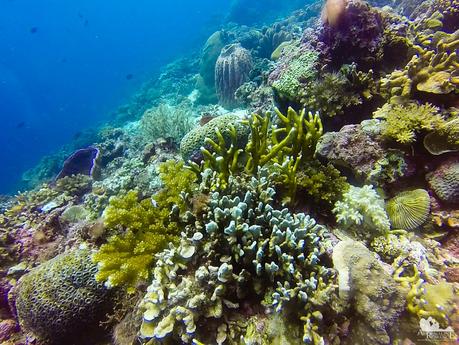
One of the nicest things about living in tropical island like Mactan in Cebu, Philippines is that we are surrounded by gorgeous coral reefs. Most of our vibrant underwater playgrounds are just less than an hour’s ride from our home. In this blue, liquid world, we witness strange biological wonders, learn more about marine biodiversity, and enhance our advocacies to preserve Mother Nature. We were able to check out another of these wonderful sites called Dakit-dakit one beautiful sunny weekend.
After depositing the garbage we collected during the Dive Against Debris reef-cleanup activity, it was time to reward ourselves. We headed back to Bluewater Maribago and set anchor just beyond these two rocks. We were going to explore an old site called Dakit-dakit, part of which is Bluewater Maribago’s in-house reef.
According to our divemaster, Dakit-dakit is named after those two rock outcroppings. The term is an old Cebuano word, its meaning lost in the mists of time.
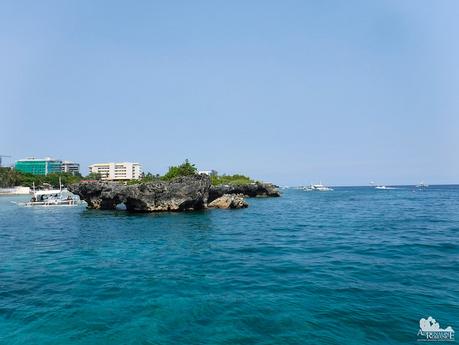
It seemed that the heavy buffet lunch we had at Crimson Spa was not enough. So, we re-filled our tummies with chicken, grilled fish, liempo (grilled pork belly), and kinilaw (seasoned raw fish) in the boat. The vinegar-and-soy sauce which the crew prepared was a killer; it was the hottest sauce we’ve ever tasted! The divine aroma and taste of several squished peppers make the sauce addictive.
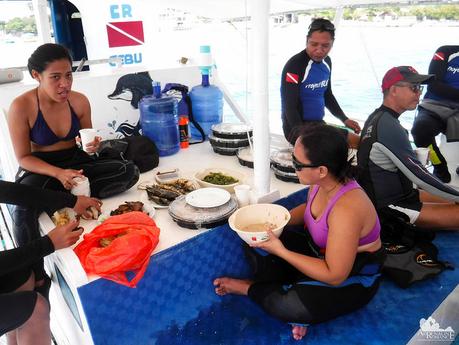
Pretty soon, it was time to gear up and enter the warm water. We submerged on top of a sandy bed with splotches of kelp, sea grass, and corals.
We also found lots of sea anemones. Sea anemones, which are closely related to jellyfish and corals, are predatory invertebrates, catching and paralyzing small fish that come too close to their stinging tentacles. They form a symbiotic relationship with anemone fish. They protect the fish from predators while the anemone fish provides them nutrients from their poop.
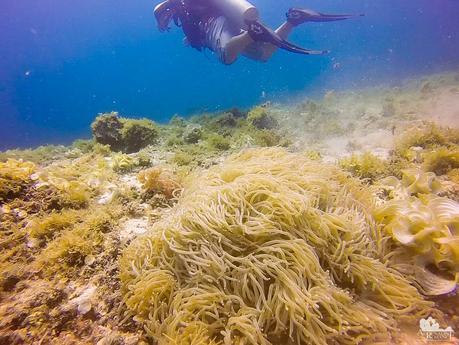
As we headed towards deeper water, marine life became more abundant. We saw multi-colored spiny sea lilies swaying gently in the current. Sea lilies start out as free-swimming feather stars. Once they find a suitable substrate, they anchor themselves on the substrate by growing a stalk.
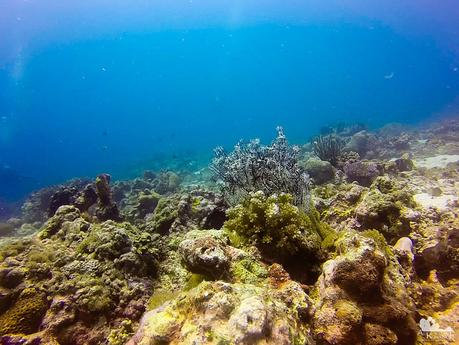
Filter-feeder barrel sponges and pipe sponges compete for space with corals. These sponges can reach up to 5 feet tall and will never stop growing until death claims them. They are favorite homes of shrimps, fish, crustaceans, and mollusks.
Here’s a strange thing about sponges. According to a study done by the National Center of Biotechnology Information, dolphins are observed to attach sponges to their rostrums (beaks) when foraging for food in the sandy seabed. This is a recent phenomenon, and scientists believe that they do this to protect their soft skin from scratches.
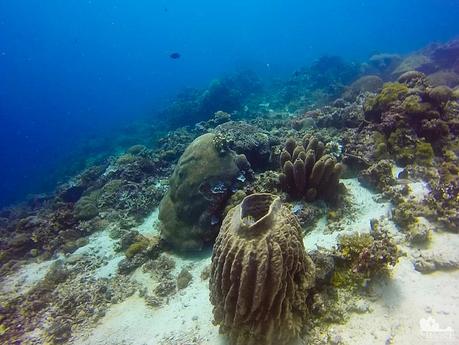
Hmmm…we saw something colorful. It’s a blue nudibranch, slithering slowly under a group of sponges. Nudibranches are shell-less slugs, but don’t let their delicate appearance fool you. They have a variety of powerful and effective defense mechanisms—aposematism (warning colors), mimicry, camouflage, bad taste, and acid secretion. There are even nudibranches that store stinging cells of the hydrozoids they eat, adopting these for their own defense!
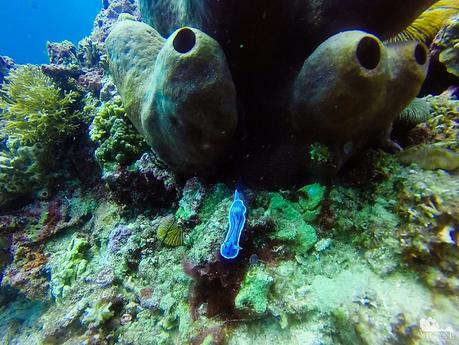
Near the lip of the kantil, a couple of black-and-yellow Valentin’s sharpnose puffers swam a close but cautious distance from us. These puffers feed mainly on algae. Like all pufferfish, they are highly poisonous.
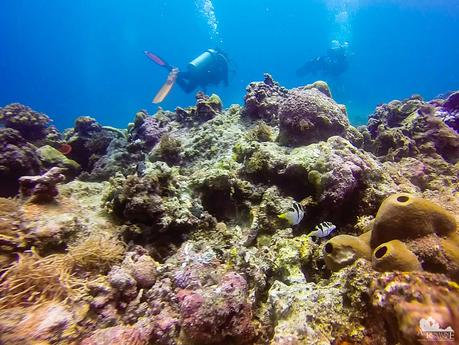
We hovered over the site’s kantil, an abyss that reaches more than 200 feet deep. Mactan’s walls are encrusted with some of the richest and most gorgeous coral reefs in the country. We hope stakeholders such as boatmen, locals, tour operators, resort owners, and locals will protect these marine treasures.
Our divemaster said that several years ago, Dakit-dakit was once a protected sanctuary. However, local divers balked at the exorbitant fees collected by the LGU. Seeing diver volume slip down, the LGU decided to remove the site’s sanctuary status to increase tourism.
While the dive site is still beautiful, it is a shadow of its former self. Elder divers recall that they found schools of eagle rays here. That would have been a fantastic sight!
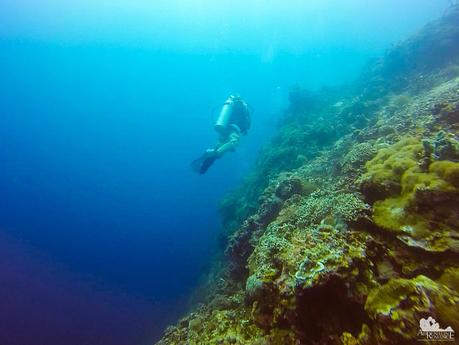
Sea fans, or gorgonians, are some of the most beautiful structures we see underwater. These are some of the most delicate corals, and a careless swipe can destroy them. Creatures such as flamingo tongue snails, fireworms, and butterflyfish prey on the polyps of these sea fans.
Gorgonians have important compounds that pharmaceutical companies consider as candidates for new drugs.
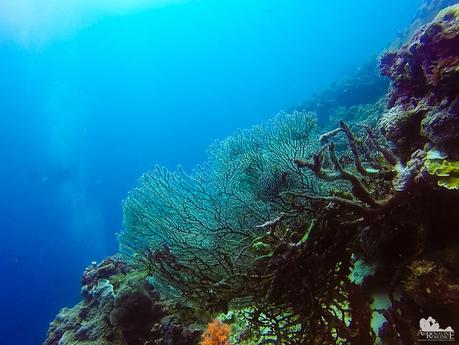
Pipe sponges and branching corals line up Dakit-dakit’s wall. A school of fish, oblivious to our presence, stayed near the wall, gorging on algae and sponges that have been growing on the rock wall.
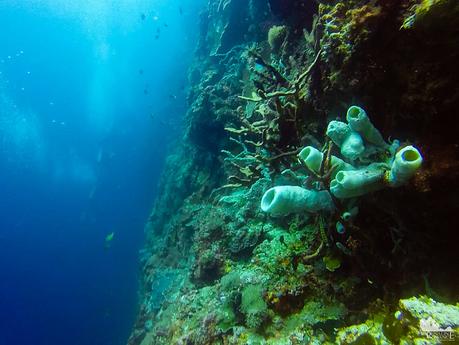
We stayed a careful distance from these small fire corals which we found at 60 feet. Fire corals, which are more related to hydras than corals, have a powerful offensive and defensive mechanism. Upon contact, microscopic nematocysts on their branches rupture, causing a horrible intense burning pain on the affected part.
We had a friend who accidentally sat on a fire coral, and she ended up in a hospital.
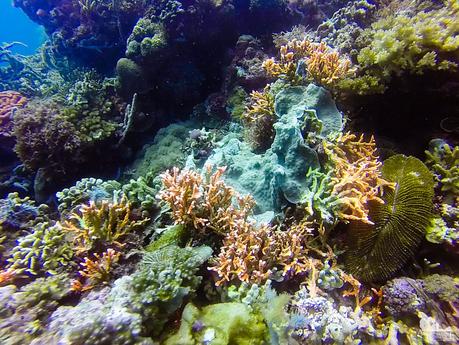
There are many different species of corals. Some of them resemble fans, lettuce leaves, tree branches, or terraces. Others like this huge brain coral look like boulders.
Corals are important in a healthy marine ecology because they are foundation species. They are nurseries, shelters, homes, and food for many marine creatures.
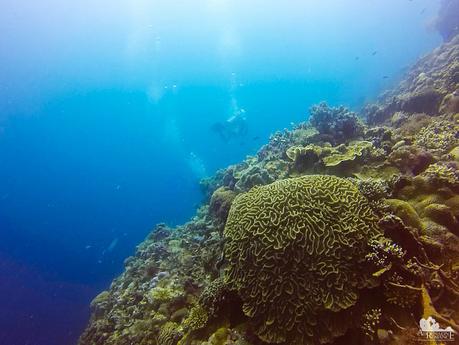
See the white stripe on that brain coral? That is coral bleaching, and most likely, it was the victim of a crown-of-thorns starfish attack. The thorny crown-of-thorns eat coral polyps, and apparently, the starfish crawled over that coral, consuming the polyps in its path.
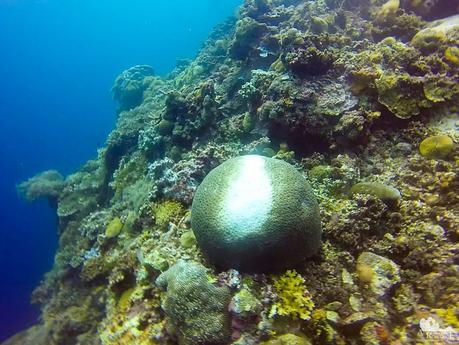
Another pufferfish! Unlike the Valentin couple earlier, this one didn’t leave its resting place, feeling confident of its defensive capabilities.
Like nudibranches, pufferfish employ a variety of defenses, from its iconic inflated mode to powerful poisons in its body to camouflage capabilities. While generally poor swimmers, they have excellent eyesight and can use their tails to cause a speed burst.
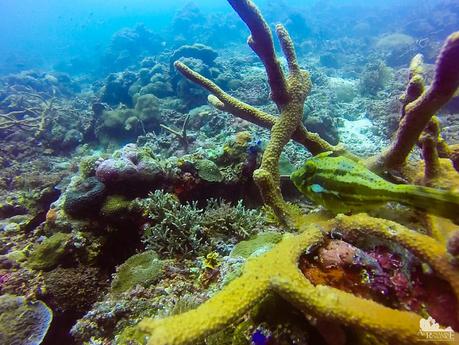
Hiding in one of the millions of crevices in the reef is this large flagtail pipefish, which we first mistook for a sea krait. Pipefish are related to sea horses and sea dragons and are generally poor swimmers. But the flagtail pipefish is an exception; it’s a strong and powerful swimmer.
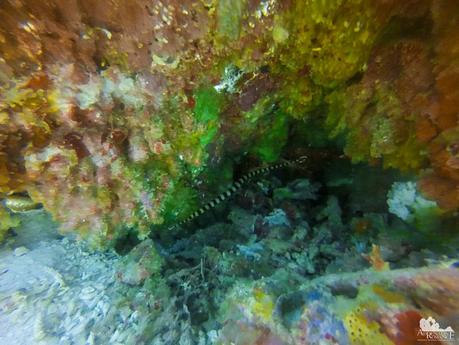
When I was a kid, I collected shells as a hobby. Thus, seeing this yellow cowrie perched on a coral with its mantle retracted revived childhood memories. Cowries are widely used as decors, jewelry, and trinkets. In some places in the world, they’re even used as currency!
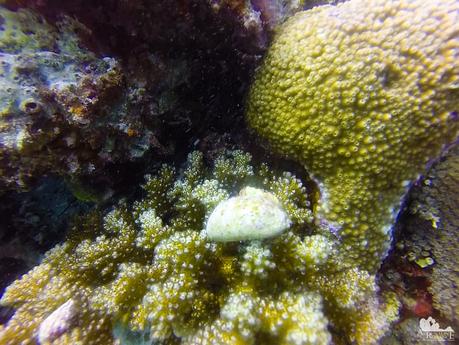
We’re not exactly sure what this ball-like creature is. We just call it a “star ball.” Yeah, the naming is shamelessly pathetic. Our divemaster later told us that it belongs to a family of sea stars although we could not see the resemblance.
Beside the “star ball” is a patch of soft coral. The end of each flower-like stalk is a set of tentacle with a mouth in the middle of it. The tentacles capture plankton, which the coral devours for food.
Update: Our friends Alieth and Uwe identified this as a cushion sea star, a type of starfish. Thank you, guys, for the ID.
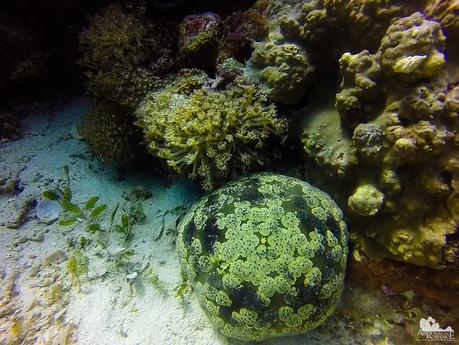
These are the remains of a dead coral. Rotting tissue and thick algae has taken over the skeleton, replacing the cavities of where the polyps used to live. As algae grows on the skeletal remains of the coral, the calcium carbonate weakens. In time, the coral skeleton decays, causing the reef structure to finally collapse.
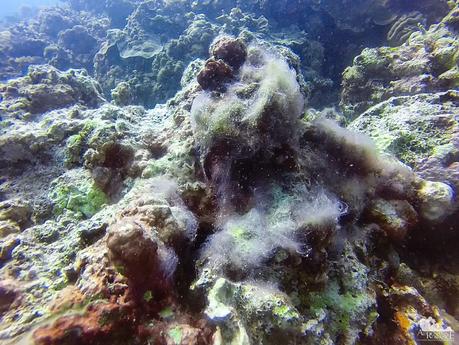
What do you think? Are these plants or corals? Or are these crinoids? Hydroids? Or something else entirely?
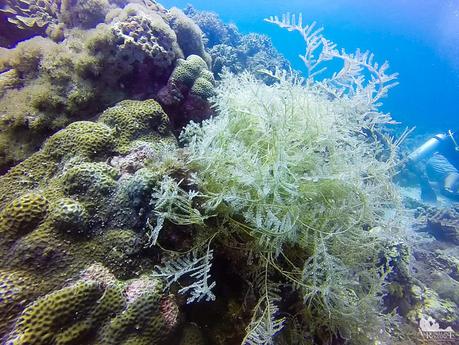
As we did a safety stop before ascending to the surface, we chanced upon this blue and yellow Phyllidia varicosa nudibranch that was hiding between the stalks of a spiky sponge. This was the largest nudibranch we’ve ever seen, almost two inches in length!
Like many nudibranches, the varicosa is toxic. As such, certain species of juvenile sea cucumber mimic the varicosa to protect themselves from predation.
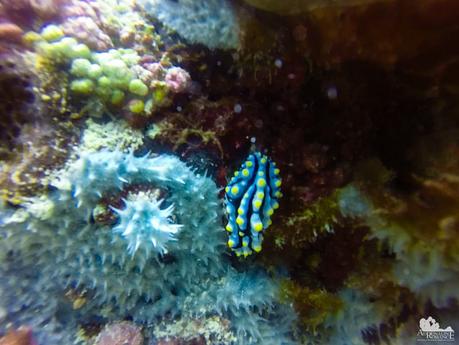
Dive sites like Dakit-dakit make our humble island a paradise for adventurers. Just like the busy, ultramodern city above the island, the reefs under the seas that surround Mactan teem with life and activity.
Scuba diving allows you not just to lay eyes on these beautiful natural creations or inject yourself with a dose of adventure. The activity also lets you learn and appreciate Mother Nature. And with appreciation and love, you develop this certain duty to protect it.
Contact Details
For guideship services, get in touch with Coral Point Divers of Aquamania, the in-house watersports outfitter of Bluewater Maribago. You can use the details below:
- Name: Aquamania Bluewater Maribago
- Street Address: Buyong Maribago, Mactan Island Lapu-lapu City Cebu, Philippines 6015
- Phone Number: (+6332) 402-4100
- Mobile: (+63998) 843-7688
- Fax: (+6332) 492-0128
- Email: [email protected]
- Website: Bluewater Maribago Beach Resort
- Facebook Page: Bluewater Maribago Beach Resort
Aquamania also offers PADI Dive Courses including specialties. They also offer watersports, island hopping trips, assistance on accommodations, and more.
Tips
1. There are more than two dozen dive sites around Mactan and Olango islands. You can’t finish them all in one day! But don’t worry because you can just stay at Bluewater Maribago for several days so you can have an awesome multi-day diving holiday.
2. You can enter Dakit-dakit from the shore. For optimum visibility, it is best to dive in the morning when the sun is shining and at the right angle. In addition, there are usually fewer divers in the morning, so heavy siltation is not likely to obscure visibility.
3. Several dive sites in Mactan and the Olango Chain have different conditions and characters. That means, some dive sites require a higher level of scuba diving experience and skill. Be sure to tell your Divemaster your skill level.
4. Establish neutral buoyancy as soon as you can to avoid touching the corals and seabed.
5. This is a high-traffic area with pumpboats, jetskis, and other watercraft zooming by. Don’t hover too close to the surface, and always be aware of your surroundings before surfacing!
6. The dive shop will take care of your scuba equipment, so you don’t have to worry if you are not bringing your own set. Pack light but do bring the following:
- extra water ( at least 2 liters per person)
- swimwear such as rash guard and swimming shorts
- aqua shoes or slippers
- snacks or packed meals
- personal medication and toiletries
- waterproof camera
- mask and snorkel (for snorkelers)
7. Be a safe and responsible diver. Always observe the Leave No Trace principle. Never touch, disturb, tease, or collect marine wildlife. Remember we are in a protected area and an alien world that demands respect.

